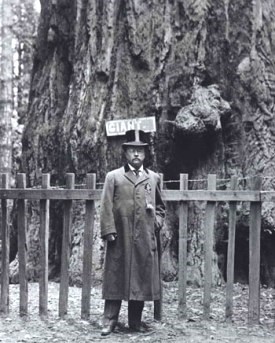
Theodore Roosevelt, often called "the conservation president," impacted the National Park System well beyond his term in office. He doubled the number of sites within the National Park system. As President from 1901 to 1909, he signed legislation establishing five new national parks: Crater Lake, Oregon; Wind Cave, South Dakota; Sullys Hill, North Dakota (later re-designated a game preserve); Mesa Verde, Colorado; and Platt, Oklahoma (now part of Chickasaw National Recreation Area). However another Roosevelt enactment had a broader effect: the Antiquities Act of June 8, 1906. The Antiquities Act enabled President Roosevelt and succeeding Presidents to proclaim historic landmarks, historic or prehistoric structures, and other objects of historic or scientific interest in federal ownership as national monuments. Roosevelt did not hesitate to take advantage of this new executive authority. By the end of 1906 he had proclaimed four national monuments: On September 24 he proclaimed Devils Tower (Wyoming). On December 8, he proclaimed El Morro (New Mexico), Montezuma Castle (Arizona), and Petrified Forest (Arizona). Additionally, he interpreted the authority expansively, protecting a large portion of the Grand Canyon (Arizona) as a national monument in 1908. By the end of his term he had reserved six predominantly cultural areas and twelve predominantly natural areas in this manner. Half of the total land area was initially administered by the Agriculture Department and was later transferred to Interior Department jurisdiction, since the National Park Service would not be created until 1916. Later Presidents have used the Antiquities Act to declare national monuments. For example, In 2018, President Donald Trump used the authority of the Antiquities Act to create Camp Nelson National Monument. Many national monuments remain as they were originally established while others have been enlarged, or redesignated national parks, or otherwise reclassified by acts of Congress. Recalling his legacy, Theodore Roosevelt is now commemorated at six units of the National Park System. Theodore Roosevelt Birthplace National Historic Site in New York City, Sagamore Hill National Historic Site in Oyster Bay, New York, Theodore Roosevelt Inaugural National Historic Site in Buffalo, New York, Theodore Roosevelt National Park in North Dakota, and Theodore Roosevelt Island in Washington, DC, all trace his career and memorialize his contributions to America. Additionally, Theodore Roosevelt is one of four Presidents gracing Mount Rushmore National Memorial in South Dakota. The National Park Service is honored to administer these park sites, and the many others Roosevelt made possible during his storied career as a conservationist. |
Last updated: December 31, 2023
